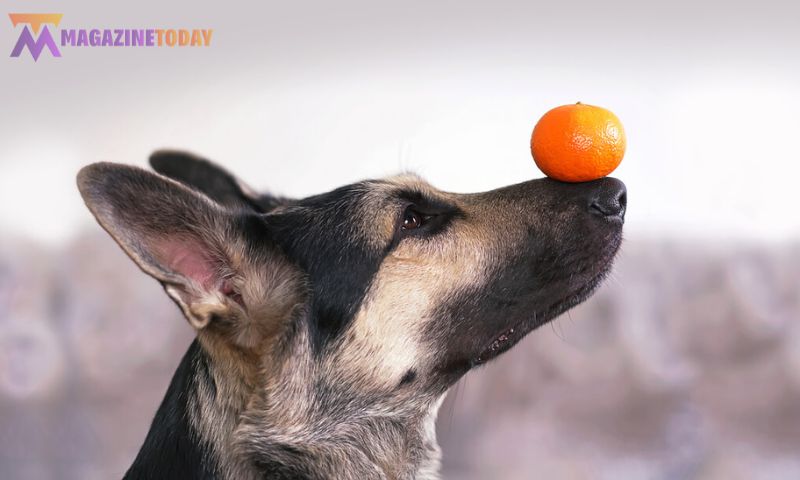Oranges are a refreshing and nutritious fruit loved by many, but when it comes to sharing them with your dog, caution is essential. Many pet owners wonder, “Can dogs eat orange peels?” The answer is not straightforward, as while the flesh of oranges can be a healthy treat in moderation, orange peels present unique challenges. This article provides insights into the risks and benefits of oranges for dogs, focusing on whether orange peels should be part of their diet.
Can Dogs Eat Oranges?


Yes, dogs can safely eat orange flesh in moderation. The juicy fruit is packed with vitamin C, fiber, and antioxidants, offering various health benefits. Oranges can boost a dog’s immune system and provide a refreshing snack. However, moderation is key, as the high sugar content can be problematic. While the flesh is safe, orange peels are another matter entirely. If you’re wondering, “Can dogs eat orange peels?” the short answer is no, and we’ll explain why in the sections below.
What Are Orange Peels, and Are They Edible?
Orange peels are the outer layer of the fruit, consisting of the zest and the white pith underneath. They are edible for humans and often used in cooking or baking. However, their tough, fibrous texture and bitter taste make them unsuitable for dogs. While some animals can handle tougher foods, dogs lack the enzymes needed to digest orange peels effectively. This leads to questions about whether they pose a health risk to dogs.
Can Dogs Eat Orange Peels? The Risks Explained


Digestive Issues
Orange peels are tough and fibrous, making them difficult for dogs to digest. Eating orange peels can lead to gastrointestinal problems like vomiting, diarrhea, or abdominal pain. These symptoms can vary based on the dog’s size and the amount of peel consumed.
Choking Hazard
The size and texture of orange peels make them a choking hazard, particularly for smaller dogs. If swallowed in large pieces, peels can obstruct the throat or digestive tract. This situation may require emergency veterinary intervention.
Chemical Exposure
Non-organic oranges are often treated with pesticides and chemicals that linger on the peel. If ingested, these chemicals can be harmful to dogs, causing mild to severe health issues. Washing the orange peel does not always remove all residues.
Essential Oils and Limonene
Orange peels contain essential oils and compounds like limonene, which can irritate a dog’s stomach and lead to discomfort. These natural oils are not easily metabolized by dogs, making them problematic.
Why Orange Flesh Is a Safer Option
Unlike orange peels, the flesh of the fruit is easier for dogs to digest and offers nutritional benefits. Orange flesh is rich in vitamin C, which can help boost a dog’s immune system. It also provides hydration and natural sugars for energy. However, you should remove all seeds, peel, and white pith before offering oranges to your dog. By avoiding the peel, you eliminate the risks of digestive upset, choking, and chemical exposure.
Alternatives to Orange Peels for Dogs
If your dog enjoys the flavor of oranges, consider offering peeled orange slices as a treat. There are also many other fruits safe for dogs that provide similar benefits:
Apples: Rich in fiber and vitamins, but be sure to remove the seeds and core.
Blueberries: Packed with antioxidants and easy for dogs to eat.
Bananas: Soft, sweet, and full of potassium.
Watermelon: A hydrating option, but avoid the seeds and rind.
These fruits are safer and more digestible than orange peels, ensuring your dog receives nutritional benefits without the associated risks.
What to Do If Your Dog Eats Orange Peels
If your dog accidentally eats orange peels, monitor them closely for signs of distress. Symptoms may include vomiting, diarrhea, lethargy, or difficulty swallowing. If these symptoms occur, contact your veterinarian immediately. While small amounts of orange peel may pass through the digestive system without issue, larger quantities can lead to complications like blockages or chemical poisoning.
How to Introduce Oranges to Your Dog


Start Slowly
Begin by offering a small piece of peeled orange to see how your dog reacts. Monitor their behavior and digestion for any adverse effects.
Remove All Peels
Always peel the orange completely before giving it to your dog. Discard the peel in a secure bin to prevent your pet from accessing it.
Serve in Moderation
Oranges should be an occasional treat, not a dietary staple. Too much citrus can lead to stomach upset due to its acidity and sugar content.
Combine with Other Fruits
Mix small amounts of orange flesh with other safe fruits to create a nutritious snack. This variety ensures your dog gets a balance of nutrients.
(FAQs)
1. Can dogs eat orange peels without getting sick?
No, orange peels are difficult to digest and can cause issues like vomiting, diarrhea, and choking. They may also contain harmful chemicals.
2. What should I do if my dog eats an orange peel?
Monitor for symptoms such as vomiting or lethargy. If your dog shows signs of distress, contact your veterinarian immediately.
3. Are there any health benefits to orange peels for dogs?
While orange peels contain nutrients, the risks outweigh the benefits. Stick to orange flesh, which is safer and easier for dogs to digest.
4. Can puppies eat orange peels?
No, puppies should not eat orange peels due to their sensitive digestive systems and smaller size, which increases choking risks.
5. Are there any safe ways to include citrus in a dog’s diet?
Yes, peeled orange slices or other citrus fruits like tangerines can be given in moderation. Always remove peels and seeds.
Final Thoughts
So, can dogs eat orange peels? The answer is clear: orange peels are not safe for dogs and should be avoided. While the fruit’s flesh offers health benefits when given in moderation, the peel poses risks such as digestive upset, choking, and chemical exposure. Always prioritize your dog’s safety by peeling oranges and offering only small, controlled portions. If you’re ever unsure about what foods are safe for your dog, consult your veterinarian for guidance. By understanding the risks and alternatives, you can ensure your pet stays happy and healthy.






